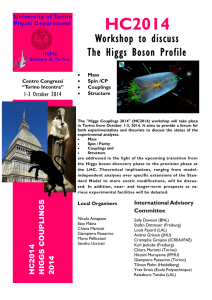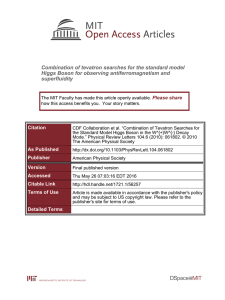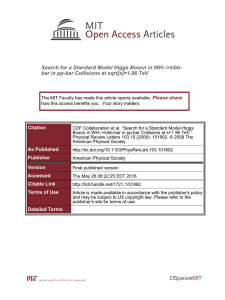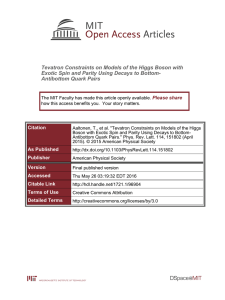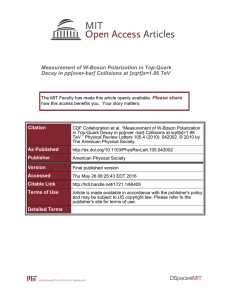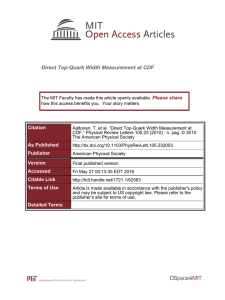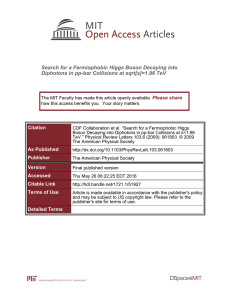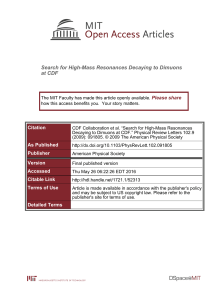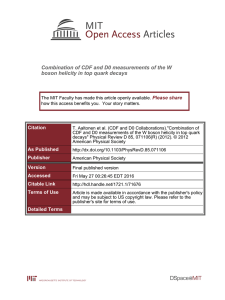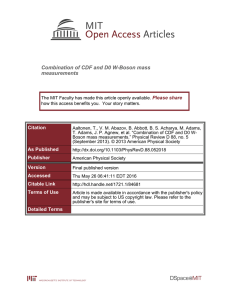Search for neutral Higgs bosons in events with multiple Please share
advertisement
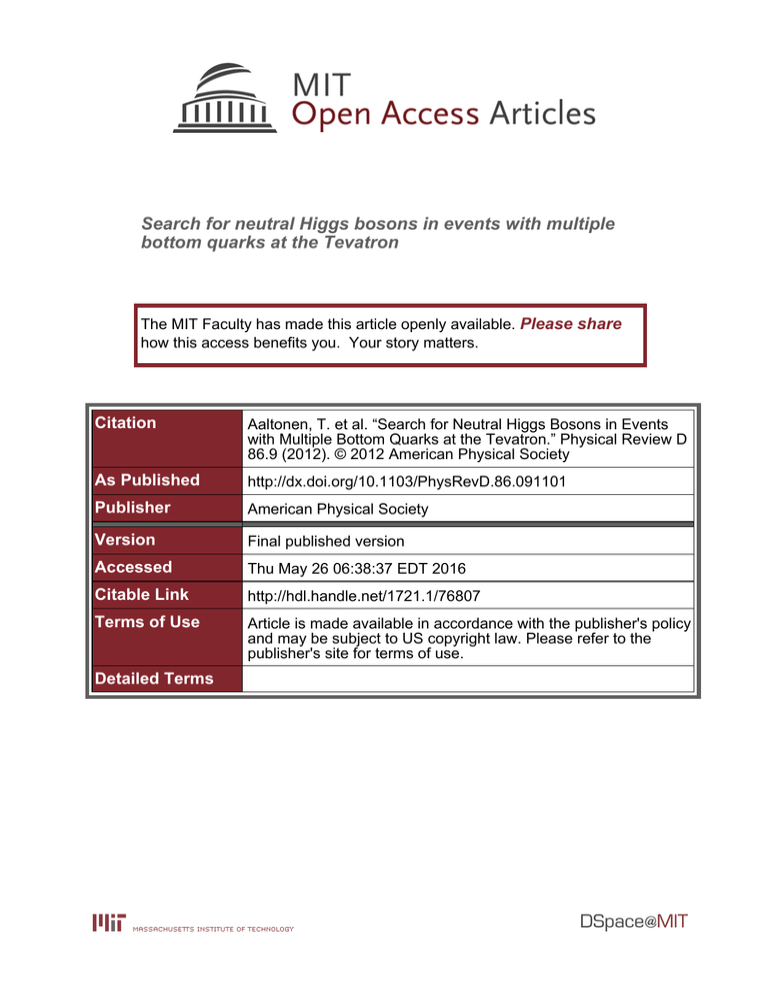
Search for neutral Higgs bosons in events with multiple bottom quarks at the Tevatron The MIT Faculty has made this article openly available. Please share how this access benefits you. Your story matters. Citation Aaltonen, T. et al. “Search for Neutral Higgs Bosons in Events with Multiple Bottom Quarks at the Tevatron.” Physical Review D 86.9 (2012). © 2012 American Physical Society As Published http://dx.doi.org/10.1103/PhysRevD.86.091101 Publisher American Physical Society Version Final published version Accessed Thu May 26 06:38:37 EDT 2016 Citable Link http://hdl.handle.net/1721.1/76807 Terms of Use Article is made available in accordance with the publisher's policy and may be subject to US copyright law. Please refer to the publisher's site for terms of use. Detailed Terms RAPID COMMUNICATIONS PHYSICAL REVIEW D 86, 091101(R) (2012) Search for neutral Higgs bosons in events with multiple bottom quarks at the Tevatron T. Aaltonen,12,* V. M. Abazov,48,† B. Abbott,112,† B. S. Acharya,31,† M. Adams,78,† T. Adams,74,† G. D. Alexeev,48,† G. Alkhazov,52,† A. Alton,96,†,ff B. Álvarez González,57,*,b G. Alverson,92,† S. Amerio,35a,* D. Amidei,96,* A. Anastassov,76,*,c A. Annovi,34,* J. Antos,53,* G. Apollinari,76,* J. A. Appel,76,* T. Arisawa,41,* A. Artikov,48,* J. Asaadi,119,* W. Ashmanskas,76,* A. Askew,74,† S. Atkins,89,† B. Auerbach,72,* K. Augsten,9,† A. Aurisano,119,* C. Avila,7,† F. Azfar,66,* F. Badaud,13,† W. Badgett,76,* T. Bae,43,* L. Bagby,76,† B. Baldin,76,† D. V. Bandurin,74,† S. Banerjee,31,† A. Barbaro-Galtieri,68,* E. Barberis,92,† P. Baringer,87,† V. E. Barnes,85,* B. A. Barnett,90,* P. Barria,36c,36a,* J. F. Bartlett,76,† P. Bartos,53,* U. Bassler,18,† M. Bauce,35b,35a,* V. Bazterra,78,† A. Bean,87,† F. Bedeschi,36a,* M. Begalli,2,† S. Behari,90,* L. Bellantoni,76,† G. Bellettini,36b,36a,* J. Bellinger,125,* D. Benjamin,109,* A. Beretvas,76,* S. B. Beri,29,† G. Bernardi,17,† R. Bernhard,22,† I. Bertram,61,† M. Besançon,18,† R. Beuselinck,63,† P. C. Bhat,76,† S. Bhatia,99,† V. Bhatnagar,29,† A. Bhatti,105,* M. Binkley,76,*,a D. Bisello,35b,35a,* I. Bizjak,64,* K. R. Bland,122,* G. Blazey,79,† S. Blessing,74,† K. Bloom,100,† B. Blumenfeld,90,* A. Bocci,109,* A. Bodek,106,* A. Boehnlein,76,† D. Boline,107,† E. E. Boos,50,† G. Borissov,61,† D. Bortoletto,85,* T. Bose,91,† J. Boudreau,116,* A. Boveia,77,* A. Brandt,118,† O. Brandt,23,† L. Brigliadori,33a,33b,* R. Brock,98,† C. Bromberg,98,* A. Bross,76,† D. Brown,17,† J. Brown,17,† E. Brucken,12,* J. Budagov,48,* X. B. Bu,76,† H. S. Budd,106,* M. Buehler,76,† V. Buescher,25,† V. Bunichev,50,† S. Burdin,61,†,gg K. Burkett,76,* G. Busetto,35a,35b,* P. Bussey,60,* C. P. Buszello,58,† A. Buzatu,4,* A. Calamba,115,* C. Calancha,56,* E. Camacho-Pérez,45,† S. Camarda,54,* M. Campanelli,64,* M. Campbell,96,* F. Canelli,77,* B. Carls,81,* D. Carlsmith,125,* R. Carosi,36a,* S. Carrillo,73,*,d S. Carron,76,* B. Casal,57,*,e M. Casarsa,38a,* B. C. K. Casey,76,† H. Castilla-Valdez,45,† A. Castro,33b,33a,* P. Catastini,93,* S. Caughron,98,† D. Cauz,38a,* V. Cavaliere,81,* M. Cavalli-Sforza,54,* A. Cerri,68,*,f L. Cerrito,64,*,g S. Chakrabarti,107,† D. Chakraborty,79,† K. M. Chan,84,† A. Chandra,121,† E. Chapon,18,† G. Chen,87,† Y. C. Chen,6,* M. Chertok,69,* S. Chevalier-Théry,18,† G. Chiarelli,36a,* G. Chlachidze,76,* F. Chlebana,76,* D. K. Cho,117,† K. Cho,43,* S. W. Cho,44,† S. Choi,44,† D. Chokheli,48,* B. Choudhary,30,† W. H. Chung,125,* Y. S. Chung,106,* S. Cihangir,76,† M. A. Ciocci,36c,36a,* D. Claes,100,† A. Clark,59,* C. Clarke,97,* J. Clutter,87,† G. Compostella,35b,35a,* M. E. Convery,76,* J. Conway,69,* M. Cooke,76,† W. E. Cooper,76,† M. Corbo,76,* M. Corcoran,121,† M. Cordelli,34,* F. Couderc,18,† M.-C. Cousinou,15,† C. A. Cox,69,* D. J. Cox,69,* F. Crescioli,36b,36a,* A. Croc,18,† J. Cuevas,57,*,b R. Culbertson,76,* D. Cutts,117,† D. Dagenhart,76,* N. d’Ascenzo,76,*,h A. Das,67,† M. Datta,76,* G. Davies,63,† P. de Barbaro,106,* S. J. de Jong,46,47,† E. De La Cruz-Burelo,45,† F. Déliot,18,† M. Dell’Orso,36b,36a,* R. Demina,106,† L. Demortier,105,* M. Deninno,33a,* D. Denisov,76,† S. P. Denisov,51,† M. d’Errico,35b,35a,* S. Desai,76,† C. Deterre,18,† K. DeVaughan,100,† F. Devoto,12,* A. Di Canto,36b,36a,* B. Di Ruzza,76,* H. T. Diehl,76,† M. Diesburg,76,† P. F. Ding,65,† J. R. Dittmann,122,* A. Dominguez,100,† S. Donati,36b,36a,* P. Dong,76,* M. D’Onofrio,62,* M. Dorigo,38a,* T. Dorigo,35a,* A. Dubey,30,† L. V. Dudko,50,† D. Duggan,101,† A. Duperrin,15,† S. Dutt,29,† A. Dyshkant,79,† M. Eads,100,† K. Ebina,41,* D. Edmunds,98,† A. Elagin,119,* J. Ellison,71,† V. D. Elvira,76,† Y. Enari,17,† A. Eppig,96,* R. Erbacher,69,* S. Errede,81,* N. Ershaidat,76,*,i R. Eusebi,119,* H. Evans,82,† A. Evdokimov,108,† V. N. Evdokimov,51,† G. Facini,92,† S. Farrington,66,* M. Feindt,24,* L. Feng,79,† T. Ferbel,106,† J. P. Fernandez,56,* F. Fiedler,25,† R. Field,73,* F. Filthaut,46,47,† W. Fisher,98,† H. E. Fisk,76,† G. Flanagan,76,*,j R. Forrest,69,* M. Fortner,79,† H. Fox,61,† M. J. Frank,122,* M. Franklin,93,* J. C. Freeman,76,* S. Fuess,76,† Y. Funakoshi,41,* I. Furic,73,* M. Gallinaro,105,* A. Garcia-Bellido,106,† J. E. Garcia,59,* J. A. Garcı́a-González,45,† G. A. Garcı́a-Guerra,45,†,hh A. F. Garfinkel,85,* P. Garosi,36a,36d,* V. Gavrilov,49,† P. Gay,13,† W. Geng,15,98,† D. Gerbaudo,102,† C. E. Gerber,78,† H. Gerberich,81,* E. Gerchtein,76,* Y. Gershtein,101,† S. Giagu,37a,* V. Giakoumopoulou,28,* P. Giannetti,36a,* K. Gibson,116,* C. M. Ginsburg,76,* G. Ginther,76,106,† N. Giokaris,28,* P. Giromini,34,* G. Giurgiu,90,* V. Glagolev,48,* D. Glenzinski,76,* M. Gold,103,* D. Goldin,119,* N. Goldschmidt,73,* A. Golossanov,76,* G. Golovanov,48,† G. Gomez-Ceballos,94,* G. Gomez,57,* M. Goncharov,94,* O. González,56,* I. Gorelov,103,* A. T. Goshaw,109,* K. Goulianos,105,* A. Goussiou,124,† P. D. Grannis,107,† S. Greder,19,† H. Greenlee,76,† G. Grenier,20,† S. Grinstein,54,* Ph. Gris,13,† J.-F. Grivaz,16,† A. Grohsjean,18,†,ii C. Grosso-Pilcher,77,* R. C. Group,123,76,* S. Grünendahl,76,† M. W. Grünewald,32,† T. Guillemin,16,† J. Guimaraes da Costa,93,* G. Gutierrez,76,† P. Gutierrez,112,† S. Hagopian,74,† S. R. Hahn,76,* J. Haley,92,† E. Halkiadakis,101,* A. Hamaguchi,40,* J. Y. Han,106,* L. Han,5,† F. Happacher,34,* K. Hara,42,* K. Harder,65,† D. Hare,101,* M. Hare,95,* A. Harel,106,† R. F. Harr,97,* K. Hatakeyama,122,* J. M. Hauptman,86,† C. Hays,66,* J. Hays,63,† T. Head,65,† T. Hebbeker,21,† M. Heck,24,* D. Hedin,79,† H. Hegab,113,† J. Heinrich,114,* A. P. Heinson,71,† U. Heintz,117,† C. Hensel,23,† I. Heredia-De La Cruz,45,† M. Herndon,125,* K. Herner,96,† G. Hesketh,65,†,jj S. Hewamanage,122,* M. D. Hildreth,84,† R. Hirosky,123,† T. Hoang,74,† J. D. Hobbs,107,† A. Hocker,76,* 1550-7998= 2012=86(9)=091101(11) 091101-1 Ó 2012 American Physical Society RAPID COMMUNICATIONS PHYSICAL REVIEW D 86, 091101(R) (2012) T. AALTONEN et al. 11,† 121,† 25,† 76,*,k S. Hou,6,* I. Howley,118,† Z. Hubacek,9,18,† B. Hoeneisen, J. Hogan, M. Hohlfeld, W. Hopkins, D. Horn, R. E. Hughes,110,* M. Hurwitz,77,* U. Husemann,72,* N. Hussain,4,* M. Hussein,98,* J. Huston,98,* V. Hynek,9,† I. Iashvili,104,† Y. Ilchenko,120,† R. Illingworth,76,† G. Introzzi,36a,* M. Iori,37b,37a,* A. S. Ito,76,† A. Ivanov,69,*,l S. Jabeen,117,† M. Jaffré,16,† E. James,76,* D. Jang,115,* A. Jayasinghe,112,† B. Jayatilaka,109,* E. J. Jeon,43,* M. S. Jeong,44,† R. Jesik,63,† S. Jindariani,76,* K. Johns,67,† E. Johnson,98,† M. Johnson,76,† A. Jonckheere,76,† M. Jones,85,* P. Jonsson,63,† K. K. Joo,43,* J. Joshi,71,† S. Y. Jun,115,* A. W. Jung,76,† T. R. Junk,76,* A. Juste,55,† K. Kaadze,88,† E. Kajfasz,15,† T. Kamon,119,* P. E. Karchin,97,* D. Karmanov,50,† A. Kasmi,112,* P. A. Kasper,76,† Y. Kato,113,*,m I. Katsanos,100,† R. Kehoe,120,† S. Kermiche,15,† W. Ketchum,77,* J. Keung,114,* N. Khalatyan,76,† A. Khanov,113,† A. Kharchilava,104,† Y. N. Kharzheev,48,† V. Khotilovich,119,* B. Kilminster,76,* D. H. Kim,43,* H. S. Kim,43,* J. E. Kim,43,* M. J. Kim,34,* S. B. Kim,43,* S. H. Kim,42,* Y. J. Kim,43,* Y. K. Kim,77,* N. Kimura,41,* M. Kirby,76,* I. Kiselevich,49,† S. Klimenko,73,* K. Knoepfel,76,* J. M. Kohli,29,† K. Kondo,41,*,a D. J. Kong,43,* J. Konigsberg,73,* A. V. Kotwal,109,* A. V. Kozelov,51,† J. Kraus,99,† M. Kreps,24,* J. Kroll,114,* D. Krop,77,* M. Kruse,109,* V. Krutelyov,119,*,n T. Kuhr,24,* S. Kulikov,51,† A. Kumar,104,† A. Kupco,10,† M. Kurata,42,* T. Kurča,20,† V. A. Kuzmin,50,† S. Kwang,77,* A. T. Laasanen,85,* S. Lami,36a,* S. Lammel,76,* S. Lammers,82,† M. Lancaster,64,* R. L. Lander,69,* G. Landsberg,117,† K. Lannon,110,*,o A. Lath,101,* G. Latino,36c,36a,* P. Lebrun,20,† T. LeCompte,75,* E. Lee,119,* H. S. Lee,44,† H. S. Lee,77,*,p J. S. Lee,43,* S. W. Lee,119,*,q S. W. Lee,86,† W. M. Lee,76,† X. Lei,67,† J. Lellouch,17,† S. Leo,36b,36a,* S. Leone,36a,* J. D. Lewis,76,* H. Li,14,† L. Li,71,† Q. Z. Li,76,† J. K. Lim,44,† A. Limosani,109,*,r D. Lincoln,76,† C.-J. Lin,68,* M. Lindgren,76,* J. Linnemann,98,† V. V. Lipaev,51,† E. Lipeles,114,* R. Lipton,76,† A. Lister,59,* D. O. Litvintsev,76,* C. Liu,116,* H. Liu,123,* H. Liu,120,† Q. Liu,85,* T. Liu,76,* Y. Liu,5,† A. Lobodenko,52,† S. Lockwitz,72,* A. Loginov,72,* M. Lokajicek,10,† R. Lopes de Sa,107,† H. J. Lubatti,124,† D. Lucchesi,35b,35a,* J. Lueck,24,* P. Lujan,68,* P. Lukens,76,* R. Luna-Garcia,45,†,kk G. Lungu,105,* A. L. Lyon,76,† R. Lysak,53,*,s J. Lys,68,* A. K. A. Maciel,1,† R. Madar,18,† R. Madrak,76,* K. Maeshima,76,* P. Maestro,36c,36a,* R. Magaña-Villalba,45,† S. Malik,105,* S. Malik,100,† V. L. Malyshev,48,† G. Manca,62,*,t A. Manousakis-Katsikakis,28,* Y. Maravin,88,† F. Margaroli,37a,* C. Marino,24,* M. Martı́nez,54,* J. Martı́nez-Ortega,45,† P. Mastrandrea,37a,* K. Matera,81,* M. E. Mattson,97,* A. Mazzacane,76,* P. Mazzanti,33a,* R. McCarthy,107,† K. S. McFarland,106,* C. L. McGivern,65,† P. McIntyre,119,* R. McNulty,62,*,u A. Mehta,62,* P. Mehtala,12,* M. M. Meijer,46,47,† A. Melnitchouk,99,† D. Menezes,79,† P. G. Mercadante,3,† M. Merkin,50,† C. Mesropian,105,* A. Meyer,21,† J. Meyer,23,† T. Miao,76,* F. Miconi,19,† D. Mietlicki,96,* A. Mitra,6,* H. Miyake,42,* S. Moed,76,* N. Moggi,33a,* N. K. Mondal,31,† M. N. Mondragon,76,*,d C. S. Moon,43,* R. Moore,76,* M. J. Morello,36d,36a,* J. Morlock,24,* P. Movilla Fernandez,76,* A. Mukherjee,76,* M. Mulhearn,123,† Th. Muller,24,* P. Murat,76,* M. Mussini,33b,33a,* J. Nachtman,76,*,v Y. Nagai,42,* J. Naganoma,41,* E. Nagy,15,† M. Naimuddin,30,† I. Nakano,39,* A. Napier,95,* M. Narain,117,† R. Nayyar,67,† H. A. Neal,96,† J. P. Negret,7,† J. Nett,119,* M. S. Neubauer,81,* C. Neu,123,* P. Neustroev,52,† J. Nielsen,68,*,w L. Nodulman,75,* S. Y. Noh,43,* O. Norniella,81,* T. Nunnemann,26,† L. Oakes,66,* S. H. Oh,109,* Y. D. Oh,43,* I. Oksuzian,123,* T. Okusawa,40,* R. Orava,12,* J. Orduna,121,† L. Ortolan,54,* N. Osman,15,† J. Osta,84,† M. Padilla,71,† S. Pagan Griso,35b,35a,* C. Pagliarone,38a,* A. Pal,118,† E. Palencia,54,*,f V. Papadimitriou,76,* A. A. Paramonov,75,* N. Parashar,83,† V. Parihar,117,† S. K. Park,44,† R. Partridge,117,†,ll N. Parua,82,† J. Patrick,76,* A. Patwa,108,† G. Pauletta,38b,38a,* M. Paulini,115,* C. Paus,94,* D. E. Pellett,69,* B. Penning,76,† A. Penzo,38a,* M. Perfilov,50,† Y. Peters,65,† K. Petridis,65,† G. Petrillo,106,† P. Pétroff,16,† T. J. Phillips,109,* G. Piacentino,36a,* E. Pianori,114,* J. Pilot,110,* K. Pitts,81,* C. Plager,70,* M.-A. Pleier,108,† P. L. M. Podesta-Lerma,45,†,mm V. M. Podstavkov,76,† L. Pondrom,125,* A. V. Popov,51,† S. Poprocki,76,*,k K. Potamianos,85,* A. Pranko,68,* M. Prewitt,121,† D. Price,82,† N. Prokopenko,51,† F. Prokoshin,48,*,x F. Ptohos,34,*,y G. Punzi,36b,36a,* J. Qian,96,† A. Quadt,23,† B. Quinn,99,† A. Rahaman,116,* V. Ramakrishnan,125,* M. S. Rangel,1,† K. Ranjan,30,† N. Ranjan,85,* P. N. Ratoff,61,† I. Razumov,51,† I. Redondo,56,* P. Renkel,120,† P. Renton,66,* M. Rescigno,37a,* T. Riddick,64,* F. Rimondi,33b,33a,* I. Ripp-Baudot,19,† L. Ristori,36a,76,* F. Rizatdinova,113,† A. Robson,60,* T. Rodrigo,57,* T. Rodriguez,114,* E. Rogers,81,* S. Rolli,95,*,z M. Rominsky,76,† R. Roser,76,* A. Ross,61,† C. Royon,18,† P. Rubinov,76,† R. Ruchti,84,† F. Ruffini,36c,36a,* A. Ruiz,57,* J. Russ,115,* V. Rusu,76,* A. Safonov,119,* G. Sajot,14,† W. K. Sakumoto,106,* Y. Sakurai,41,* P. Salcido,79,† A. Sánchez-Hernández,45,† M. P. Sanders,26,† L. Santi,38b,38a,* A. S. Santos,1,†,nn K. Sato,42,* G. Savage,76,† V. Saveliev,76,*,h A. Savoy-Navarro,76,*,aa L. Sawyer,89,† T. Scanlon,63,† R. D. Schamberger,107,† Y. Scheglov,52,† H. Schellman,80,† P. Schlabach,76,* S. Schlobohm,124,† A. Schmidt,24,* E. E. Schmidt,76,* C. Schwanenberger,65,† T. Schwarz,76,* R. Schwienhorst,98,† L. Scodellaro,57,* A. Scribano,36c,36a,* F. Scuri,36a,* S. Seidel,103,* Y. Seiya,40,* J. Sekaric,87,† A. Semenov,48,* H. Severini,112,† F. Sforza,36c,36a,* E. Shabalina,23,† S. Z. Shalhout,69,* V. Shary,18,† S. Shaw,98,† A. A. Shchukin,51,† T. Shears,62,* 091101-2 24,* RAPID COMMUNICATIONS PHYSICAL REVIEW D 86, 091101(R) (2012) SEARCH FOR NEUTRAL HIGGS BOSONS IN EVENTS . . . 116,* 42,*,bb 30,† 77,* M. Shimojima, I. Shreyber-Tecker,49,* V. Simak,9,† P. F. Shepard, R. K. Shivpuri, M. Shochet, A. Simonenko,48,* P. Sinervo,4,* P. Skubic,112,† P. Slattery,106,† K. Sliwa,95,* D. Smirnov,84,† J. R. Smith,69,* K. J. Smith,104,† F. D. Snider,76,* G. R. Snow,100,† J. Snow,111,† S. Snyder,108,† A. Soha,76,* S. Söldner-Rembold,65,† H. Song,116,* L. Sonnenschein,21,† V. Sorin,54,* K. Soustruznik,8,† P. Squillacioti,36c,36a,* R. St. Denis,60,* M. Stancari,76,* J. Stark,14,† O. Stelzer-Chilton,4,* B. Stelzer,4,* D. Stentz,76,*,c D. A. Stoyanova,51,† M. Strauss,112,† J. Strologas,103,* G. L. Strycker,96,* Y. Sudo,42,* A. Sukhanov,76,* I. Suslov,48,* L. Suter,65,† P. Svoisky,112,† M. Takahashi,65,† K. Takemasa,42,* Y. Takeuchi,42,* J. Tang,77,* M. Tecchio,96,* P. K. Teng,6,* J. Thom,76,*,k J. Thome,115,* G. A. Thompson,81,* E. Thomson,114,* M. Titov,18,† D. Toback,119,* S. Tokar,53,* V. V. Tokmenin,48,† K. Tollefson,98,* T. Tomura,42,* D. Tonelli,76,* S. Torre,34,* D. Torretta,76,* P. Totaro,35a,* M. Trovato,36d,36a,* Y.-T. Tsai,106,† K. Tschann-Grimm,107,† D. Tsybychev,107,† B. Tuchming,18,† C. Tully,102,† F. Ukegawa,42,* S. Uozumi,43,* L. Uvarov,52,† S. Uvarov,52,† S. Uzunyan,79,† R. Van Kooten,82,† W. M. van Leeuwen,46,† N. Varelas,78,† A. Varganov,96,* E. W. Varnes,67,† I. A. Vasilyev,51,† F. Vázquez,73,*,d G. Velev,76,* C. Vellidis,76,* P. Verdier,20,† A. Y. Verkheev,48,† L. S. Vertogradov,48,† M. Verzocchi,76,† M. Vesterinen,65,† M. Vidal,85,* I. Vila,57,* D. Vilanova,18,† R. Vilar,57,* J. Vizán,57,* M. Vogel,103,* P. Vokac,9,† G. Volpi,34,* P. Wagner,114,* R. L. Wagner,76,* H. D. Wahl,74,† T. Wakisaka,40,* R. Wallny,70,* S. M. Wang,6,* M. H. L. S. Wang,76,† A. Warburton,4,* J. Warchol,84,† D. Waters,64,* G. Watts,124,† M. Wayne,84,† J. Weichert,25,† L. Welty-Rieger,80,† W. C. Wester III,76,* A. White,118,† D. Whiteson,114,*,cc F. Wick,24,* D. Wicke,27,† A. B. Wicklund,75,* E. Wicklund,76,* S. Wilbur,77,* H. H. Williams,114,* M. R. J. Williams,61,† G. W. Wilson,87,† J. S. Wilson,110,* P. Wilson,76,* B. L. Winer,110,* P. Wittich,76,*,k M. Wobisch,89,† S. Wolbers,76,* H. Wolfe,110,* D. R. Wood,92,† T. Wright,96,* X. Wu,59,* Z. Wu,122,* T. R. Wyatt,65,† Y. Xie,76,† R. Yamada,76,† K. Yamamoto,40,* D. Yamato,40,* S. Yang,5,† T. Yang,76,* U. K. Yang,77,*,dd W.-C. Yang,65,† Y. C. Yang,43,* W.-M. Yao,68,* T. Yasuda,76,† Y. A. Yatsunenko,48,† W. Ye,107,† Z. Ye,76,† G. P. Yeh,76,* K. Yi,76,*,v H. Yin,76,† K. Yip,108,† J. Yoh,76,* K. Yorita,41,* T. Yoshida,40,*,ee S. W. Youn,76,† G. B. Yu,109,* I. Yu,43,* J. M. Yu,96,† S. S. Yu,76,* J. C. Yun,76,* A. Zanetti,38a,* Y. Zeng,109,* J. Zennamo,104,† T. Zhao,124,† T. G. Zhao,65,† B. Zhou,96,† C. Zhou,109,* J. Zhu,96,† M. Zielinski,106,† D. Zieminska,82,† L. Zivkovic,117,† and S. Zucchelli33b,33a,* (*CDF Collaboration) (†D0 Collaboration) 1 LAFEX, Centro Brasileiro de Pesquisas Fı́sicas, Rio de Janeiro, Brazil 2 Universidade do Estado do Rio de Janeiro, Rio de Janeiro, Brazil 3 Universidade Federal do ABC, Santo André, Brazil 4 Institute of Particle Physics: McGill University, Montréal, Québec, Canada H3A 2T8; Simon Fraser University, Burnaby, British Columbia, Canada V5A 1S6; University of Toronto, Toronto, Ontario, Canada M5S 1A7; and TRIUMF, Vancouver, British Columbia, Canada V6T 2A3 5 University of Science and Technology of China, Hefei, People’s Republic of China 6 Institute of Physics, Academia Sinica, Taipei, Taiwan 11529, Republic of China 7 Universidad de los Andes, Bogotá, Colombia 8 Charles University, Faculty of Mathematics and Physics, Center for Particle Physics, Prague, Czech Republic 9 Czech Technical University in Prague, Prague, Czech Republic 10 Center for Particle Physics, Institute of Physics, Academy of Sciences of the Czech Republic, Prague, Czech Republic 11 Universidad San Francisco de Quito, Quito, Ecuador 12 Division of High Energy Physics, Department of Physics, University of Helsinki and Helsinki Institute of Physics, FIN-00014, Helsinki, Finland 13 LPC, Université Blaise Pascal, CNRS/IN2P3, Clermont, France 14 LPSC, Université Joseph Fourier Grenoble 1, CNRS/IN2P3, Institut National Polytechnique de Grenoble, Grenoble, France 15 CPPM, Aix-Marseille Université, CNRS/IN2P3, Marseille, France 16 LAL, Université Paris-Sud, CNRS/IN2P3, Orsay, France 17 LPNHE, Universités Paris VI and VII, CNRS/IN2P3, Paris, France 18 CEA, Irfu, SPP, Saclay, France 19 IPHC, Université de Strasbourg, CNRS/IN2P3, Strasbourg, France 20 IPNL, Université Lyon 1, CNRS/IN2P3, Villeurbanne, France and Université de Lyon, Lyon, France 21 III. Physikalisches Institut A, RWTH Aachen University, Aachen, Germany 22 Physikalisches Institut, Universität Freiburg, Freiburg, Germany 23 II. Physikalisches Institut, Georg-August-Universität Göttingen, Göttingen, Germany 091101-3 RAPID COMMUNICATIONS PHYSICAL REVIEW D 86, 091101(R) (2012) T. AALTONEN et al. 24 Institut für Experimentelle Kernphysik, Karlsruhe Institute of Technology, D-76131 Karlsruhe, Germany 25 Institut für Physik, Universität Mainz, Mainz, Germany 26 Ludwig-Maximilians-Universität München, München, Germany 27 Fachbereich Physik, Bergische Universität Wuppertal, Wuppertal, Germany 28 University of Athens, 157 71 Athens, Greece 29 Panjab University, Chandigarh, India 30 Delhi University, Delhi, India 31 Tata Institute of Fundamental Research, Mumbai, India 32 University College Dublin, Dublin, Ireland 33a Istituto Nazionale di Fisica Nucleare Bologna, I-40127 Bologna, Italy 33b University of Bologna, I-40127 Bologna, Italy 34 Laboratori Nazionali di Frascati, Istituto Nazionale di Fisica Nucleare, I-00044 Frascati, Italy 35a Istituto Nazionale di Fisica Nucleare, Sezione di Padova-Trento, I-35131 Padova, Italy 35b University of Padova, I-35131 Padova, Italy 36a Istituto Nazionale di Fisica Nucleare Pisa, I-56127 Pisa, Italy 36b University of Pisa, I-56127 Pisa, Italy 36c University of Siena, I-56127 Pisa, Italy 36d Scuola Normale Superiore, I-56127 Pisa, Italy 37a Istituto Nazionale di Fisica Nucleare, I-00185 Roma, Italy 37b Sezione di Roma 1, Sapienza Università di Roma, I-00185 Roma, Italy 38a Istituto Nazionale di Fisica Nucleare Trieste/Udine, I-34100 Trieste, I-33100 Udine, Italy 38b University of Udine, I-33100 Udine, Italy 39 Okayama University, Okayama 700-8530, Japan 40 Osaka City University, Osaka 588, Japan 41 Waseda University, Tokyo 169, Japan 42 University of Tsukuba, Tsukuba, Ibaraki 305, Japan 43 Center for High Energy Physics: Kyungpook National University, Daegu 702-701, Korea; Seoul National University, Seoul 151-742, Korea; Sungkyunkwan University, Suwon 440-746, Korea; Korea Institute of Science and Technology Information, Daejeon 305-806, Korea; Chonnam National University, Gwangju 500-757, Korea; Chonbuk National University, Jeonju 561-756, Korea 44 Korea Detector Laboratory, Korea University, Seoul, Korea 45 CINVESTAV, Mexico City, Mexico 46 Nikhef, Science Park, Amsterdam, the Netherlands 47 Radboud University Nijmegen, Nijmegen, the Netherlands 48 Joint Institute for Nuclear Research, Dubna, Russia 49 Institute for Theoretical and Experimental Physics, Moscow 117259, Russia 50 Moscow State University, Moscow, Russia 51 Institute for High Energy Physics, Protvino, Russia 52 Petersburg Nuclear Physics Institute, St. Petersburg, Russia 53 Comenius University, 842 48 Bratislava, Slovakia; Institute of Experimental Physics, 040 01 Kosice, Slovakia 54 Institut de Fisica d’Altes Energies, ICREA, Universitat Autonoma de Barcelona, E-08193, Bellaterra (Barcelona), Spain 55 Institució Catalana de Recerca i Estudis Avançats (ICREA) and Institut de Fı́sica d’Altes Energies (IFAE), Barcelona, Spain 56 Centro de Investigaciones Energeticas Medioambientales y Tecnologicas, E-28040 Madrid, Spain 57 Instituto de Fisica de Cantabria, CSIC-University of Cantabria, 39005 Santander, Spain 58 Uppsala University, Uppsala, Sweden 59 University of Geneva, CH-1211 Geneva 4, Switzerland 60 Glasgow University, Glasgow G12 8QQ, United Kingdom 61 Lancaster University, Lancaster LA1 4YB, United Kingdom 62 University of Liverpool, Liverpool L69 7ZE, United Kingdom 63 Imperial College London, London SW7 2AZ, United Kingdom 64 University College London, London WC1E 6BT, United Kingdom 65 The University of Manchester, Manchester M13 9PL, United Kingdom 66 University of Oxford, Oxford OX1 3RH, United Kingdom 67 University of Arizona, Tucson, Arizona 85721, USA 68 Ernest Orlando Lawrence Berkeley National Laboratory, Berkeley, California 94720, USA 69 University of California, Davis, Davis, California 95616, USA 70 University of California, Los Angeles, Los Angeles, California 90024, USA 71 University of California, Riverside, Riverside, California 92521, USA 72 Yale University, New Haven, Connecticut 06520, USA 091101-4 RAPID COMMUNICATIONS SEARCH FOR NEUTRAL HIGGS BOSONS IN EVENTS . . . PHYSICAL REVIEW D 86, 091101(R) (2012) 73 University of Florida, Gainesville, Florida 32611, USA Florida State University, Tallahassee, Florida 32306, USA 75 Argonne National Laboratory, Argonne, Illinois 60439, USA 76 Fermi National Accelerator Laboratory, Batavia, Illinois 60510, USA 77 Enrico Fermi Institute, University of Chicago, Chicago, Illinois 60637, USA 78 University of Illinois at Chicago, Chicago, Illinois 60607, USA 79 Northern Illinois University, DeKalb, Illinois 60115, USA 80 Northwestern University, Evanston, Illinois 60208, USA 81 University of Illinois, Urbana, Illinois 61801, USA 82 Indiana University, Bloomington, Indiana 47405, USA 83 Purdue University Calumet, Hammond, Indiana 46323, USA 84 University of Notre Dame, Notre Dame, Indiana 46556, USA 85 Purdue University, West Lafayette, Indiana 47907, USA 86 Iowa State University, Ames, Iowa 50011, USA 87 University of Kansas, Lawrence, Kansas 66045, USA 88 Kansas State University, Manhattan, Kansas 66506, USA 89 Louisiana Tech University, Ruston, Louisiana 71272, USA 90 The Johns Hopkins University, Baltimore, Maryland 21218, USA 91 Boston University, Boston, Massachusetts 02215, USA 92 Northeastern University, Boston, Massachusetts 02115, USA 93 Harvard University, Cambridge, Massachusetts 02138, USA 94 Massachusetts Institute of Technology, Cambridge, Massachusetts 02139, USA 74 a Deceased. CDF visitor from Universidad de Oviedo, E-33007 Oviedo, Spain. c CDF visitor from Northwestern University, Evanston, IL 60208, USA. d CDF visitor from Universidad Iberoamericana, Mexico D.F., Mexico. e CDF visitor from ETH, 8092 Zurich, Switzerland. f CDF visitor from CERN, CH-1211 Geneva, Switzerland. g CDF visitor from Queen Mary, University of London, London, E1 4NS, United Kingdom. h CDF visitor from National Research Nuclear University, Moscow, Russia. i CDF visitor from Yarmouk University, Irbid 211-63, Jordan. j CDF visitor from Muons, Inc., Batavia, IL 60510, USA. k CDF visitor from Cornell University, Ithaca, NY 14853, USA. l CDF visitor from Kansas State University, Manhattan, KS 66506, USA. m CDF visitor from Kinki University, Higashi-Osaka City, Japan 577-8502. n CDF visitor from University of California, Santa Barbara, Santa Barbara, CA 93106, USA. o CDF visitor from University of Notre Dame, Notre Dame, IN 46556, USA. p CDF visitor from Ewha Womans University, Seoul, 120-750, Korea. q CDF visitor from Texas Tech University, Lubbock, TX 79609, USA. r CDF visitor from University of Melbourne, Victoria 3010, Australia. s CDF visitor from Institute of Physics, Academy of Sciences of the Czech Republic, Czech Republic. t CDF visitor from Istituto Nazionale di Fisica Nucleare, Sezione di Cagliari, 09042 Monserrato (Cagliari), Italy. u CDF visitor from University College Dublin, Dublin 4, Ireland. v CDF visitor from University of Iowa, Iowa City, IA 52242, USA. w CDF visitor from University of California, Santa Cruz, Santa Cruz, CA 95064, USA. x CDF visitor from Universidad Tecnica Federico Santa Maria, 110v Valparaiso, Chile. y CDF visitor from University of Cyprus, Nicosia CY-1678, Cyprus. z CDF visitor from Office of Science, U.S. Department of Energy, Washington, DC 20585, USA. aa CDF visitor from CNRS-IN2P3, Paris, F-75205 France. bb CDF visitor from Nagasaki Institute of Applied Science, Nagasaki, Japan. cc CDF visitor from University of California, Irvine, Irvine, CA 92697, USA. dd CDF visitor from University of Manchester, Manchester M13 9PL, United Kingdom. ee CDF visitor from University of Fukui, Fukui City, Fukui Prefecture, Japan 910-0017. ff D0 visitor from Augustana College, Sioux Falls, SD, USA. gg D0 visitor from The University of Liverpool, Liverpool, United Kingdom. hh D0 visitor from UPIITA-IPN, Mexico City, Mexico. ii D0 visitor from DESY, Hamburg, Germany. jj D0 visitor from University College London, London, United Kingdom. kk D0 visitor from Centro de Investigacion en Computacion-IPN, Mexico City, Mexico. ll D0 visitor from SLAC, Menlo Park, CA, USA. mm D0 visitor from ECFM, Universidad Autonoma de Sinaloa, Culiacán, Mexico. nn D0 visitor from Universidade Estadual Paulista, São Paulo, Brazil. b 091101-5 RAPID COMMUNICATIONS PHYSICAL REVIEW D 86, 091101(R) (2012) T. AALTONEN et al. 95 Tufts University, Medford, Massachusetts 02155, USA University of Michigan, Ann Arbor, Michigan 48109, USA 97 Wayne State University, Detroit, Michigan 48201, USA 98 Michigan State University, East Lansing, Michigan 48824, USA 99 University of Mississippi, University, Mississippi 38677, USA 100 University of Nebraska, Lincoln, Nebraska 68588, USA 101 Rutgers University, Piscataway, New Jersey 08855, USA 102 Princeton University, Princeton, New Jersey 08544, USA 103 University of New Mexico, Albuquerque, New Mexico 87131, USA 104 State University of New York, Buffalo, New York 14260, USA 105 The Rockefeller University, New York, New York 10065, USA 106 University of Rochester, Rochester, New York 14627, USA 107 State University of New York, Stony Brook, New York 11794, USA 108 Brookhaven National Laboratory, Upton, New York 11973, USA 109 Duke University, Durham, North Carolina 27708, USA 110 The Ohio State University, Columbus, Ohio 43210, USA 111 Langston University, Langston, Oklahoma 73050, USA 112 University of Oklahoma, Norman, Oklahoma 73019, USA 113 Oklahoma State University, Stillwater, Oklahoma 74078, USA 114 University of Pennsylvania, Philadelphia, Pennsylvania 19104, USA 115 Carnegie Mellon University, Pittsburgh, Pennsylvania 15213, USA 116 University of Pittsburgh, Pittsburgh, Pennsylvania 15260, USA 117 Brown University, Providence, Rhode Island 02912, USA 118 University of Texas, Arlington, Texas 76019, USA 119 Texas A&M University, College Station, Texas 77843, USA 120 Southern Methodist University, Dallas, Texas 75275, USA 121 Rice University, Houston, Texas 77005, USA 122 Baylor University, Waco, Texas 76798, USA 123 University of Virginia, Charlottesville, Virginia 22904, USA 124 University of Washington, Seattle, Washington 98195, USA 125 University of Wisconsin, Madison, Wisconsin 53706, USA (Received 11 July 2012; published 6 November 2012) 96 The combination of searches performed by the CDF and D0 collaborations at the Fermilab Tevatron Collider for neutral Higgs bosons produced in association with b quarks is reported. The data, corresponding to 2:6 fb1 of integrated luminosity at CDF and 5:2 fb1 at D0, have been collected in final states containing three or more b jets. Upper limits are set on the cross section multiplied by the branching ratio varying between 44 pb and 0.7 pb in the Higgs boson mass range 90 to 300 GeV, assuming production of a narrow scalar boson. Significant enhancements to the production of Higgs bosons can be found in theories beyond the standard model, for example, in supersymmetry. The results are interpreted as upper limits in the parameter space of the minimal supersymmetric standard model in a benchmark scenario favoring this decay mode. DOI: 10.1103/PhysRevD.86.091101 PACS numbers: 14.80.Da, 12.38.Qk, 12.60.Fr, 13.85.Rm In the standard model (SM), electroweak symmetry breaking is achieved through the introduction of a single scalar doublet field, and the existence of a single neutral scalar boson [1–6] is predicted. However, extensions of the SM exist with richer structure. Introducing a second Higgs doublet, such as in type II 2-Higgs doublet models (2HDM) [7], leads to multiple scalar bosons and can give scenarios with enhanced couplings to down-type fermions. Supersymmetry is a plausible extension to the SM that introduces an additional symmetry between fermions and bosons. The two Higgs boson doublets in the minimal supersymmetric standard model (MSSM) [8,9] lead to five physical Higgs bosons: three neutral (collectively denoted as ): h, H, and A; and two charged: H þ and H . At leading order the MSSM is a type II 2HDM model, and two parameters are sufficient to describe the Higgs sector. These are conventionally chosen as the ratio of the two Higgs doublet vacuum expectation values, tan, and, MA , the mass of the pseudoscalar boson, A. The couplings to the down-type fermions are enhanced by a factor of tan relative to those in the SM. Thus, the main decay mode is with branching fractions near 90% at leading ! bb, order (the remainder being mostly ! þ ). While searches for -lepton-pair final states at hadron colliders are relatively insensitive to higher-order radiative corrections, due to cancellations between the production and decay processes, this is not the case for decays to bb. Thus, information from decays to bb together with 091101-6 RAPID COMMUNICATIONS PHYSICAL REVIEW D 86, 091101(R) (2012) SEARCH FOR NEUTRAL HIGGS BOSONS IN EVENTS . . . þ stringent limits from decays to can constrain higherorder effects and yield additional information about electroweak symmetry breaking, supersymmetry, or other new physics beyond the SM with similar final states such as pair production of color octet scalars [10–12]. Since an inclusive search for ! bb is difficult due to large multijet backgrounds, these searches rely on the case where the boson is produced in association with one or more b quarks. This final state with at least three b quarks represents a powerful search channel, with the third b jet providing additional suppression of the large multijet background at a hadron collider. MSSM Higgs boson production has been studied at the CERN LEP eþ e collider excluding Mh;A < 93 GeV for all tan values [13]. The CDF [14–16] and D0 [17–26] collaborations extended such searches to higher masses and for large tan. The most stringent upper limits on tan in searches for neutral Higgs production for masses above the LEP bounds come from searches in final states with leptons pair produced at the Large Hadron Collider [27–29]. The results reported in this paper make use of pp collisions at a center of mass energy of 1.96 TeV. The data, corresponding to integrated luminosities of 2:6 fb1 and 5:2 fb1 , were collected during Run II at the Fermilab Tevatron Collider by the CDF and D0 collaborations, respectively. The combination of searches for neutral Higgs bosons in final states with three or more b jets [16,23] is presented. The CDF and D0 detectors are described in Refs. [30–33]. A brief outline of the reconstruction of the final states and event selection used in these searches follows. A cone algopffiffiffiffiffiffiffiffiffiffiffiffiffiffiffiffiffiffiffiffiffiffiffiffiffiffiffiffiffiffiffi rithm [34] with a radius of R ¼ ðyÞ2 þ ð’Þ2 ¼ 0:7 (CDF) and 0.5 (D0), where y is the rapidity and ’ the azimuthal angle, is used to reconstruct jets from energy deposition in the calorimeters. Identification of jets arising from b-quark fragmentation (b tagging) uses an algorithm based on reconstructing secondary vertices of charged particles displaced from the pp interaction vertex at CDF [35] and a neural network combining lifetime information from secondary vertices and the minimum distance of approach of charged particle trajectories to the primary interaction at D0 [36]. The performance of the b-tagging algorithms and the associated probabilities for jets to pass the tagging requirements are assessed from control samples in data. Events are selected at CDF with dedicated online event selections (triggers) requiring at least two jets and using b-tagging information, while at least three jets are required at D0. For most of the data collected at D0, b-tagging information is also used in the trigger decision. Events are selected offline with at least three jets within the fiducial region. This is defined by requirements on the momentum transverse to the proton beam direction, pT , and detector pseudorapidity, det ¼ lnðtanð=2ÞÞ, of jets, where is the polar angle with respect to the proton beam direction and an origin at the center of the detector: three jets with pT > 20 GeV and jdet j < 2:0 at CDF and three jets with pT > 20 GeV and at least two jets with pT > 25 GeV, jdet j < 2:5 at D0. Events with more jets are accepted at CDF but only the four jets with the highest pT are used in the analysis. Exclusive channels with exactly three or exactly four jets are used at D0. The signal sample is defined by both experiments requiring at least three b-tagged jets, without distinguishing between those jets arising from b quark and anti-b quark fragmentation. In the CDF inclusive and the D0 four-jet channel the first two jets, ordered by decreasing pT , and at least one of the third and fourth jets are required to be b tagged. In addition, a large sample requiring only two b-tagged jets is used by both experiments to build models of the multijet backgrounds. At CDF, the background is modeled using a sum of templates of the invariant mass distribution of the two jets with the highest pT , representing contributions from different background modes categorized according to kinematics and flavor content. The templates are constructed from events in the double-tagged data sample where at least one of the two highest pT jets is b tagged. The events are then weighted according to the probability for at least one of the jets with no b tag to pass the tagging requirements under three different assumptions as to whether it arises from a b quark, a c quark, or a light quark (or gluon). This results in six different mass templates. The separation between the different components is enhanced by using an additional jet-flavor-sensitive discriminant, xtags , that makes use of kinematic properties of the charged particles from secondary vertices associated with each b-tagged jet. In the D0 analysis the background model is formed by correcting the shape of the dijet invariant mass distribution of a data sample with two b-tagged jets using the ratio of simulated multijet samples with three b tags and two b tags. The simulated samples are generated using ALPGEN [37] with showering and hadronization carried out using PYTHIA [38] and detailed simulation of the detector using GEANT [39]. Their flavor composition, in terms of the relative numbers of b, c, and light jets per event, is determined from a simultaneous fit to the data across samples with differing numbers of tagged jets, different b-tag operating points, and in small intervals of the scalar sum of the transverse momenta of the jets. The shape correction is applied as a function of the dijet invariant mass and the value of a likelihood-ratio discriminant, L, designed to select signal-like events in preference to backgroundlike events. Only the two jet pairings from the highest pT jet plus either the second or third highest pT jet are considered when forming Higgs candidates, and the choice that gives the highest value of L > 0:65 is selected. If neither pairing in the event is above this threshold then the event is discarded. Systematic uncertainties are assessed to take into account the imperfect modeling of the background simulation. However, the definition of the correction as a 091101-7 RAPID COMMUNICATIONS PHYSICAL REVIEW D 86, 091101(R) (2012) T. AALTONEN et al. ratio of distributions significantly reduces the sensitivity of the final model to these imperfections. Small contributions to the background from top-quark-pair production are simulated using ALPGEN and PYTHIA. Backgrounds from other sources, such as Z ! bb and single-top-quark production are negligible. The efficiency for selecting signal is estimated for both analyses using events generated with PYTHIA. Associated production of a boson and a b quark, gb ! b, with is used to model the signal. subsequent decay ! bb, The signal cross section, experimental acceptance, and the kinematics are corrected to next-to-leading order using MCFM [40,41], weighting events as a function of the kinematics of the highest pT b-quark jet not associated with the Higgs decay. Approximately 11 500 events are selected by CDF with at least three b tags and an estimated product of signal efficiency and acceptance varying as a function of M between 0.18% at M ¼ 90 GeV and 0.8% at M ¼200GeV. Approximately 15 000 and 11 000 events with at least three b-tagged jets are accepted in the D0 three-jet and four-jet channels, respectively. The corresponding signal efficiencies for a Higgs of mass M ¼ 200 GeV are 1.2% and 0.6%. The channels are combined and exclusion limits set, using the modified frequentist technique [42,43], with a log likelihood ratio (LLR) as the test statistic: pðXjH1 Þ LLR ¼ 2 ln ; pðXjH0 Þ where p represents the probabilities that the data, X, are drawn from the background-only (H0 ), and signal-plusbackground (H1 ) hypotheses, respectively. The likelihoods are constructed from the binned two-dimensional distribution of the dijet invariant mass versus the xtags discriminant for CDF and the binned one-dimensional dijet invariant mass distribution for D0. Theoretical predictions of the absolute rates for the multijet backgrounds have large uncertainties. Therefore, additional scale factors are TABLE I. Observed and expected upper limits at the 95% C.L., and the best-fit value, , ^ on the product of cross section and branching ratio ðpp ! bXÞ BRð ! bbÞ, within the acceptance for the highest pT b quark not arising from the Higgs decay [41]. Expected limits are given for the median and for 1 and 2 standard deviation (s.d.) variations of the background expectation. Values for the best-fit signal are extracted without a constraint that they remain positive. M (GeV) 90 100 110 120 130 140 150 160 170 180 190 200 210 220 230 240 250 260 270 280 290 300 Obs. (pb) 2 s.d. 38 43 43 44 25 26 18 12 9.4 7.1 5.7 5.0 3.8 3.3 2.5 2.0 2.0 1.7 1.3 1.1 0.82 0.71 30 22 15 12 8.1 5.1 4.1 3.3 2.5 2.4 2.2 2.0 1.6 1.2 1.0 0.9 0.9 0.7 0.7 0.6 0.6 0.5 (1) Expected upper limit (pb) 1 s.d. median þ1 s.d. 41 30 20 15 9.6 7.3 5.5 4.5 3.6 3.2 2.5 2.4 2.2 1.7 1.5 1.2 1.1 1.0 0.9 0.8 0.8 0.7 091101-8 57 42 27 20 14 10 7.4 6.0 5.0 4.2 4.0 3.0 2.6 2.2 2.0 1.8 1.6 1.4 1.2 1.1 1.1 1.0 81 62 39 29 19 14 11 8.5 7.0 6.0 5.0 4.4 3.7 3.2 3.0 2.5 2.3 2.2 2.0 1.7 1.9 1.6 þ2 s.d. 110 86 53 39 25 20 15 12 9.5 8.2 7.0 6.0 5.0 4.7 4.1 3.5 3.2 2.8 2.4 2.4 2.4 2.3 ^ (pb) 42þ28 28 1:6þ20 18 21þ14 13 27þ9 9 15þ7 7 16þ6 5 11þ5 4 6:5þ3:5 3:1 5:1þ3:1 2:6 3:3þ2:2 2:0 2:4þ1:8 1:6 2:2þ1:5 1:4 1:3þ1:2 1:1 1:1þ1:1 1:0 0:55þ0:95 0:87 0:27þ0:79 0:76 0:23þ0:67 0:64 0:27þ0:59 0:56 0:09þ0:51 0:49 0:00þ0:45 0:43 0:43þ0:42 0:42 0:50þ0:38 0:38 RAPID COMMUNICATIONS SEARCH FOR NEUTRAL HIGGS BOSONS IN EVENTS . . . PHYSICAL REVIEW D 86, 091101(R) (2012) applied to the background yield in the D0 analysis and the individual templates in the CDF analysis and introduced into the likelihood as parameters with no external constraints. Systematic uncertainties are introduced as either shape or normalization variations to the model probability density functions. These systematics are governed by nuisance parameters together with Gaussian constraint terms where appropriate [44]. Sources of uncertainty related to a common component of the luminosity determination and the theoretical modeling of the signal production are considered fully correlated. All other sources of uncertainty are assumed to be uncorrelated. The modeling of the b-jettagging efficiency and the contamination from light-quark and gluon jets are the dominant sources of uncertainty on the background model. These are implemented as uncertainties that affect the shape of the distributions entering the likelihood. Additional subdominant uncertainties are considered in the D0 analysis arising in the modeling of the trigger, jet efficiency, jet energy scale, and jet resolution. While most of those effects have a negligible impact on the background model, effects that are dependent on the differences between b, light, and gluon jets can be significant. Dominant experimental systematic uncertainties on the signal model can be attributed to luminosity (6%), b-tagging efficiency (11%–18%), and jet energy scale (2%–10% depending on the boson mass hypothesis). Limits on the product of the cross section and the branching ratio using the LLR test statistic are extracted. The limits are model independent, apart from assuming a single narrow Higgs boson mass peak, dominated by experimental resolution effects. Together with the best-fit value of the product of the signal cross section times branching ratio, these are summarized in Table I, and presented in Fig. 1. The combination gives a sensitivity that is better than the D0 expected limit alone by 25% at M ¼ 100 GeV, steadily falling to <1% by M ¼ 300 GeV. Excesses of events above the SM background expectation are observed for M ¼ 120 and 140 GeV with significances of 2.5 standard deviations and 2.6 standard deviations, respectively. These are driven by the excesses observed in the individual contributing analyses of 2.8 standard deviations at M ¼ 150 GeV at CDF and 2.5 standard deviations at M ¼ 120 GeV at D0. A standard convention [45] is used to account for the effect that it is more likely to find a deviation (under the background-only) hypothesis when several mass regions are probed compared with only a single hypothesis. The significance of the excesses in the combined analysis is reduced to 2 standard deviations. Though these limits are the key results of this search, it is interesting to interpret them in terms of constraints on benchmark models within the MSSM. As a consequence of the enhanced couplings to b quarks at large tan, the total width of the Higgs boson increases with tan. When this width becomes comparable to the experimental resolution of 15%–20% there is an impact on the sensitivity of the search. When interpreting the exclusion within the MSSM, the width of the Higgs boson and the enhancement of the product of cross section and branching ratio above that of the SM are calculated using FEYNHIGGS [46–51]. The width is included in the simulation of the signal as a function of mass and tan by convoluting a relativistic Breit-Wigner function with the next-to-leading order cross section [40]. Additional uncertainties for these model-specific limits are considered that otherwise cancel in the model-independent limit. For comparison these are derived as in previous results [16,20,23]: uncertainties on the SM signal cross section are derived from varying the Tevatron, 2.6-5.2 fb Tevatron exclusion LEP exclusion 90 -1 80 Observed Expected 70 Expected ±1 s.d. 60 Expected ±2 s.d. 10 tanβ σ(gb → φ b) × BR(φ→ bb) 95% CL [pb] 10 2 Tevatron 2.6-5.2 fb-1 mh max, µ=-200 GeV 50 40 Observed Expected Exp. ± 1 s.d. Exp. ± 2 s.d. 30 20 1 10 100 150 200 250 100 300 150 200 250 300 M A [GeV] M φ [GeV] FIG. 1 (color online). Model-independent 95% C.L. upper limits on the product of cross section and branching ratio for the combined analyses, assuming a Higgs boson width significantly smaller than the experimental resolution. The dark and light shaded regions correspond to the one and 2 standard deviation bands around the median expected limit. FIG. 2 (color online). 95% C.L. lower limit in the ðMA ; tanÞ plane for the mmax h , ¼ 200 GeV, including Higgs boson width effects and using the fact that for the tan range considered, either h and A, or H and A (depending on MA ) are effectively mass degenerate. The exclusion limit obtained from the LEP experiments is also shown. 091101-9 RAPID COMMUNICATIONS PHYSICAL REVIEW D 86, 091101(R) (2012) T. AALTONEN et al. factorization and renormalization scales by a factor of 2 and from uncertainties on the parton distribution functions. The uncertainties assessed from scale variation are taken to be 10% and the parton distribution functions contribute an additional 3.5%–13%, depending on the mass hypothesis. The masses and couplings of the Higgs bosons in the MSSM depend, in addition to tan and MA , on other parameters through radiative corrections. Limits on tan as a function of MA are derived for the mmax scenario [52] h that favors the bb final state, assuming a CP-conserving Higgs sector [53] and a negative value of the Higgs sector bilinear coupling . Figure 2 shows exclusion limits in the ðtan; MA Þ plane for this scenario. Adding a further potential theoretical uncertainty on the signal cross section of 20%, independent of M , would lead to an increase of 5% in the tan limit. In summary, the combination of results on neutral Higgs boson searches in multi-b-jet events from CDF and D0 has been presented. Upper limits are set on the product of the cross section and branching ratio and constraints are placed in the ðtan; MA Þ plane for a particular MSSM scenario. This combination, with more than half the integrated luminosity from the Tevatron still to be analyzed, provides the most stringent limits on neutral Higgs boson production and decay in the multi-b-jet mode. F. Englert and R. Brout, Phys. Rev. Lett. 13, 321 (1964). P. W. Higgs, Phys. Lett. 12, 132 (1964). P. W. Higgs, Phys. Rev. Lett. 13, 508 (1964). G. S. Guralnik, C. R. Hagen, and T. W. B. Kibble, Phys. Rev. Lett. 13, 585 (1964). P. W. Higgs, Phys. Rev. 145, 1156 (1966). T. W. B. Kibble, Phys. Rev. 155, 1554 (1967). V. Barger, J. L Hewett, and R. J. N. Phillips, Phys. Rev. D 41, 3421 (1990). H. P. Nilles, Phys. Rep. 110, 1 (1984). H. E. Haber and G. L. Kane, Phys. Rep. 117, 75 (1985). B. A. Dobrescu, K. Kong, and R. Mahbubani, Phys. Lett. B 670, 119 (2008). M. Gerbush, T. J. Khoo, D. J. Phalen, A. Pierce, and D. Tucker-Smith, Phys. Rev. D 77, 095003 (2008). Y. Bai and B. A. Dobrescu, J. High Energy Phys. 07 (2011) 100. ALEPH Collaboration, DELPHI Collaboration, L3 Collaboration, and OPAL Collaboration, Eur. Phys. J. C 47, 547 (2006). T. Affolder et al. (CDF Collaboration), Phys. Rev. Lett. 86, 4472 (2001). A. Abulencia et al. (CDF Collaboration), Phys. Rev. Lett. 96, 011802 (2006). T. Aaltonen et al. (CDF Collaboration), Phys. Rev. D 85, 032005 (2012). V. M. Abazov et al. (D0 Collaboration), Phys. Rev. Lett. 95, 151801 (2005). V. M. Abazov et al. (D0 Collaboration), Phys. Rev. Lett. 97, 121802 (2006). [19] V. M. Abazov et al. (D0 Collaboration), Phys. Rev. Lett. 101, 071804 (2008). [20] V. M. Abazov et al. (D0 Collaboration), Phys. Rev. Lett. 101, 221802 (2008). [21] V. M. Abazov et al. (D0 Collaboration), Phys. Rev. Lett. 102, 051804 (2009). [22] V. M. Abazov et al. (D0 Collaboration), Phys. Rev. Lett. 104, 151801 (2010). [23] V. M. Abazov et al. (D0 Collaboration), Phys. Lett. B 698, 97 (2011). [24] V. M. Abazov et al. (D0 Collaboration), Phys. Rev. Lett. 107, 121801 (2011). [25] V. M. Abazov et al. (D0 Collaboration), Phys. Lett. B 707, 323 (2012). [26] V. M. Abazov et al. (D0 Collaboration), Phys. Lett. B 710, 569 (2012). [27] CMS Collaboration, Phys. Rev. Lett. 106, 231801 (2011). [28] ATLAS Collaboration, Phys. Lett. B 705, 174 (2011). [29] CMS Collaboration, Phys. Lett. B 713, 68 (2012). [30] D. Acosta et al. (CDF Collaboration), Phys. Rev. D 71, 032001 (2005). [31] V. M. Abazov et al. (D0 Collaboration), Nucl. Instrum. Methods Phys. Res., Sect. A 565, 463 (2006). [32] M. Abolins et al., Nucl. Instrum. Methods Phys. Res., Sect. A 584, 75 (2008). [33] R. Angstadt et al., Nucl. Instrum. Methods Phys. Res., Sect. A 622, 298 (2010). [34] G. Blazey et al., arXiv:hep-ex/0005012. [1] [2] [3] [4] [5] [6] [7] [8] [9] [10] [11] [12] [13] [14] [15] [16] [17] [18] We thank the Fermilab staff and technical staffs of the participating institutions for their vital contributions and acknowledge support from the DOE and NSF (USA), ARC (Australia), CNPq, FAPERJ, FAPESP and FUNDUNESP (Brazil), NSERC (Canada), NSC, CAS and CNSF (China), Colciencias (Colombia), MSMT and GACR (Czech Republic), the Academy of Finland, CEA and CNRS/ IN2P3 (France), BMBF and DFG (Germany), DAE and DST (India), SFI (Ireland), INFN (Italy), MEXT (Japan), the Korean World Class University Program and NRF (Korea), CONACyT (Mexico), FOM (Netherlands), MON, NRC KI and RFBR (Russia), the Slovak R&D Agency, the Ministerio de Ciencia e Innovación, and Programa Consolider-Ingenio 2010 (Spain), The Swedish Research Council (Sweden), SNSF (Switzerland), STFC and the Royal Society (United Kingdom), and the A. P Sloan Foundation (USA). 091101-10 RAPID COMMUNICATIONS SEARCH FOR NEUTRAL HIGGS BOSONS IN EVENTS . . . PHYSICAL REVIEW D 86, 091101(R) (2012) [35] D. Acosta et al. (CDF Collaboration), Phys. Rev. D 71, 052003 (2005). [36] V. M. Abazov et al. (D0 Collaboration), Nucl. Instrum. Methods Phys. Res., Sect. A 620, 490 (2010). [37] M. L. Mangano, F. Piccinini, A. D. Polosa, M. Moretti, and R. Pittau, J. High Energy Phys. 07 (2003) 001. ALPGEN version 2.11 is used. [38] T. Sjöstrand, S. Mrenna, and P. Skands, J. High Energy Phys. 05 (2006) 026. Version 6.409 is used. [39] R. Brun and F. Carminati, CERN program library long writeup Report No. W5013, 1993. [40] J. Campbell, R. K. Ellis, F. Maltoni, and S. Willenbrock, Phys. Rev. D 67, 095002 (2003). [41] Cross sections are quoted with respect to the requirements that the highest pT b quark not from the Higgs decay has pT > 12 GeV and jj < 5:0. [42] T. Junk, Nucl. Instrum. Methods Phys. Res., Sect. A 434, 435 (1999). [43] A. Read, Nucl. Instrum. Methods Phys. Res., Sect. A 425, 357 (1999). [44] W. Fisher, Report No. FERMILAB-TM-2386-E, 2007. [45] The ALEPH Collaboration, The DELPHI Collaboration, The L3 Collaboration, and The OPAL Collaboration, Phys. Lett. B 565, 61 (2003). [46] S. Heinemeyer, W. Hollik, and G. Weiglein, Eur. Phys. J. C 9, 343 (1999). FEYNHIGGS version 2.6.8 is used. [47] S. Heinemeyer, W. Hollik, and G. Weiglein, Comput. Phys. Commun. 124, 76 (2000). [48] G. Degrassi, S. Heinemeyer, W. Hollik, P. Slavich, and G. Weiglein, Eur. Phys. J. C 28, 133 (2003). [49] M. Frank, T. Hahn, S. Heinemeyer, W. Hollik, H. Rzehak, and G. Weiglein, J. High Energy Phys. 02 (2007) 047. [50] L. Hofer, U. Nierste, and D. Shere, J. High Energy Phys. 10 (2009) 081. [51] D. Noth and M. Spira, Phys. Rev. Lett. 101, 181801 (2008). [52] MSUSY ¼ 1 TeV, Xt ¼ 2 TeV, M2 ¼ 0:2 TeV jj ¼ 0:2 TeV, and mg ¼ 0:8 TeV. [53] M. Carena, S. Heinemeyer, C. E. M. Wagner, and G. Weiglein, Eur. Phys. J. C 45, 797 (2006). 091101-11
